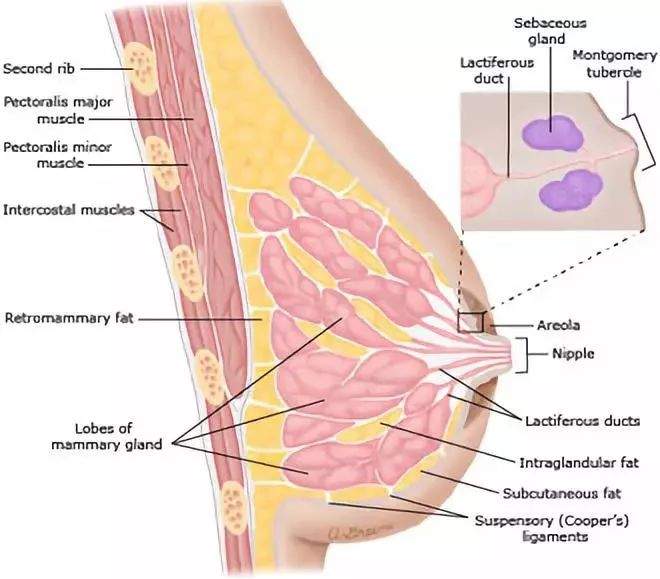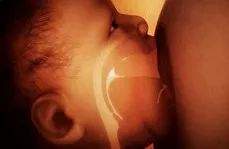Breast milk is the most suitable food for newborns. In order to enable babies to drink [golden colostrum] as soon as they are born, more and more pregnant mothers begin to worry about large breasts, small breasts, nipple shape, nipple cleaning and other issues from pregnancy.
Today, I invited Chen Ying, a college obstetrics and gynecology teacher and an international certified lactation consultant (IBCLC), to talk with us about the common worries and concerns of pregnant mothers.
Small breasts and no milk? Big breasts and plenty of milk?
Breast size has nothing to do with more milk and less milk.
The vast majority of breast tissue is fat (yellow tissue in the figure below), and breast size only means more fat.
The real milk is produced by breast tissue (pink tissue in the figure below). The amount of glandular tissue has nothing to do with the appearance and size of the breast.

The thing that subverts cognition has come: the bigger the breast, the better. On the contrary, the bigger the breast, the insufficient milk may be.
Studies have shown that obesity may lead to endocrine imbalance, which may delay lactation or insufficient milk. In addition, too large breasts may lead to nipple shortening and affect the baby’s inclusion. Therefore, weight should be controlled to an appropriate range before and during pregnancy.
Does breast plastic surgery affect lactation?
Some pregnant mothers have undergone breast augmentation or breast reduction plasty before and are very concerned about whether breast plastic surgery will affect breast feeding.
However, it is really not clear whether it is related.
Because this is related to many factors such as the operation method, the choice of incision and the degree of damage to breast anatomical structure.
In general:
Breast prosthesis implantation for breast augmentation has little influence on breast feeding.
There are a large number of literatures reporting the risk of lactation infection after breast augmentation injection.
At present, there is no evidence that autologous fat transplantation for breast augmentation cannot be breast-fed. You can communicate with a doctor. If the situation is good, you can try breast-feeding.
The influence of breast reduction on lactation is different. If doctors keep more glands during the operation, avoid damaging breast ducts, and pay attention to protecting the blood supply and nerve of nipple and areola, then the hope of lactation is very great.
Because of individual differences and different surgical methods, breast-feeding mothers should pay attention to the growth and development of their children and their own state. If there is any abnormality, they should seek medical treatment in time.
Can flat and sunken nipples be breast-fed?
Some mothers find their nipples very flat and even concave inside. Will this affect future lactation?
In fact, most flat and sunken nipples do not affect lactation.
Because the baby sucks not only the nipple, but also the nipple and the breast tissue under the areola are put into the mouth together to form a [long nipple], and the nipple only accounts for one third of the [long nipple].
If the elasticity of areola part is good, as long as the baby can eat it, it doesn’t matter what the nipple looks like.

Another good news is that nipple depression is not static.
Especially for mothers who are pregnant for the first time, incomplete nipple protrusion is a very common phenomenon.
About one-third of mothers have some degree of nipple depression, but in the last three months of pregnancy, in order to prepare for lactation, the mother’s skin will gradually become more elastic, and many nipple depression can gradually correct itself.
Therefore, mothers should not worry too much and do not need to stretch or handle too much during pregnancy.
The nipple squeezed out the liquid, what is the situation?
In the third trimester of pregnancy, many mothers can squeeze out yellow or other colors of liquid, which is actually colostrum.
After 16 weeks of pregnancy, the breast has developed to the extent that it can produce milk, instead of starting to produce milk after delivery.
Some mothers will worry: How much colostrum is there? Will there be any light leakage and the baby will not have to eat at birth?
Don’t worry, colostrum is not limited. From then on, almost all mothers can produce sufficient milk after delivery whenever they give birth.
Of course, it doesn’t mean that there is no milk outflow during pregnancy. There is no need to squeeze it deliberately. Just let nature take its course.
Nipple areola is dirty, do you want to scrub it often?
Some mothers will feel dirty nipples and want to clean them up for fear that their children will have diarrhea in the future.
But in fact, this is also unnecessary, normal bath cleaning is OK.
Not all bacteria are bad. Breastfeeding itself is bacteria feeding.
After birth, the baby has close contact with the mother. During lactation, the baby first comes into contact with the nipples and bacteria around the nipples on the mother’s chest, then sucks and drinks the bacteria and milk in the milk tube.

These microorganisms entering the baby’s oral cavity and milk enter the baby’s digestive tract together to form intestinal flora that protects the baby’s intestinal tract.
The mother’s intestinal tract, oral cavity, amniotic fluid, placenta and birth canal are not sterile. The mother’s body contains a large amount of probiotics precious to the baby. In other words, your baby has been in contact with your bacteria in your belly.
The old man often said [dirty, not sick after eating], although it is not entirely correct, but there is also some truth. Children do not live in a vacuum, and proper contact with bacteria is not a bad thing.
In fact, breast-feeding is a natural and normal thing. Mothers-to-be will be able to feed their babies well by unloading their burdens and strengthening their confidence.
